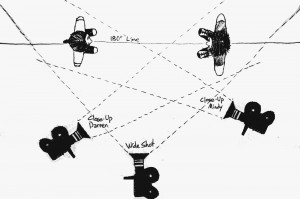Quote of the day: “The bigger the space or gap, the higher the art is”.
Editing is deliberately breaking things to encourage audience to fill the gaps themselves. It is so that when audiences read texts, they would give itself the meanings. Representation consists of connotations that we understand through our own experience of our own understanding of the “world”. Contexts also contributes to we understand representations. Therefore, editing is about creating gaps by taking away time and place, while making sequence that doesn’t go in an orderly manner. This encourages the audience make their own readings, to “think” and creating meaningful meanings. In this week 4 lectorial, we did a little activity involving cards and had to create series of events that can be reordered in different chronologic. The activity therefore, represents editing sequences in storytelling.
i.e. Continuity editing:
The 180 degree rule.
The Koulechov Effect:
Is a montage editing technique. It is about interpreting events and meanings based on the gaps they fill. An example of this effect is a close-up shot of a person’s face, that is followed by a shot of a food in a plate. We would automatically infer that the person is hungry. While our mind is separated from the body, making conclusions without thinking. But if that shot of a person’s face is followed by a shot of a crying young girl. We would infer a different meaning, where the person is sympathising the crying girl.
https://www.youtube.com/watch?v=TNVf1N34-io

